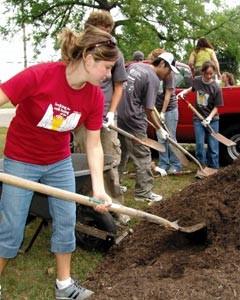
Instructor's Corner #2: The Potential, Power, and Pitfalls of Communication Service-Learning
In its most basic form, service learning asks students to practice in community settings what they are learning in their disciplines. The hope is that their work will benefit others. Service learning is rapidly proliferating in communication classes, leading some scholars to claim that communication is a disciplinary leader in service learning. This study asked community partners what was working and what must be improved in their experience of communication service learning projects.
Extensive research demonstrates that service learning builds community connections, makes coursework relevant to students, and helps students use academic concepts to solve real-world problems. Unfortunately, there is much less research evaluating the benefits of service learning from the perspective of community partners themselves. In the present project, community partners were interviewed about their experiences with communication service learning projects.
I interviewed 15 staff members from 15 different nonprofit organizations about their experiences working with students in service learning projects related to an interpersonal and small group communication class. My participants included directors, associate directors, volunteer coordinators, community coordinators, and directors of development. Their organizations engaged in a wide variety of missions, including education, health care, community crisis management, youth development, and workforce training, among others.
First, community partners identified three major benefits of communication service learning. Initially, the community partners overwhelmingly felt students provided needed and valuable services. Students were seen as being able to provide time to undertake projects the organization’s staff typically could not, bring excitement/new energy to the organization, and offer communication skills (especially related to technology) agencies really needed.
Additionally, service learning has been criticized as allowing students to feel good by volunteering a few hours without addressing structural causes of poverty. However, these community partners believed service learning in communication courses helped students obtain knowledge about the needs of the community and who those in need might be. Students became more aware of the nonprofit agencies working in the community and gained confidence they could make a difference on issues of community need.
Further, community partners were excited about the opportunity for students to apply communication vocabulary in a real-world context and to encounter unexpected events that deepened their learning. This application of communication vocabulary in the real world helped students not only refine their learning of theory, but also further develop their interpersonal communication skills in general.
Second, the community partners identified three major pitfalls of communication service learning in their experiences. Initially, the community partners revealed students typically did not care if they learned anything related to communication. Students were often obsessed with just completing the required hours and sought the easiest task to fill their time. Several of the partners felt as if the students’ professors were not clearly communicating what students should gain from service learning.
Additionally, community partners expressed communication with faculty (particularly in the physical space of the community agency) would help community partners collaborate with faculty in achieving meaningful learning objectives for students. Unfortunately, the community partners overwhelmingly vented that faculty had mostly failed to make any contact before (or during) the students’ service learning experiences. Any contact from faculty seemed superficial and insignificant to community partners.
Further, community partners felt their opportunity to guide student learning was limited because faculty were not soliciting meaningful feedback on student performance. Some community partners indicated they were asked to fill out a feedback form, but typically those forms only asked them to confirm the number of hours students worked and nothing more. Other partners were not asked for any feedback at all.
This study, then, leads to three key pieces of advice for improving communication service learning. First, community partners describe students as not typically aware of the instructional goals of service learning. This is likely a result of one of the most frequent designs of communication service learning projects. In this type of assignment, students are asked to reflect on their service learning retroactively, perhaps by writing journals or a paper after they have completed the service, tying the service to course concepts. For example, a student may work three hours each week in a soup kitchen. This experience may lead the student, upon reflection, to better understand theoretical conceptions of power, social norms, and poverty. From this perspective, service is of benefit to learning, but learning does not necessarily benefit service.
Instructors must make the learninggoals of service learning clear to students before they enter the community rather than allow students to make sense of learning only after the fact. Good reflection should be continuous (before, during, and after). This should involve specific discussions of which course concepts might be applied and preparatory assignments that ask students to proactively identify which concepts they intend to engage before completing their service. Moreover, those goals must be clearly shared with community partners, who really desire to design service projects consistent with classroom goals, but often feel they have no idea how to do that.
Second, these discussions should not simply be a one-way communication path from faculty to community partners. The community partners universally desire more significant and sustained faculty interaction. To do that, faculty must make time at least to meet the community partners and communicate the learning goals the faculty have for service learning. Then they should sincerely inquire if those goals fit the needs of the potential community partner.
Finally, community partners desire faculty to solicit meaningful feedback from them regarding student performance. When students are sent out to do work in the community, their evaluation should take into account whether the work they did with and for the community partner was valuable.
In the end, by more clearly and proactively defining learning outcomes with students and community partners, developing relationships between community partners and faculty, and seeking community partners’ feedback, faculty can capitalize on the positive aspects of service learning for students, classrooms, and communities by providing a stronger experience for all involved.

